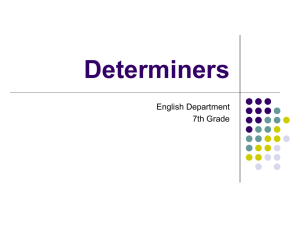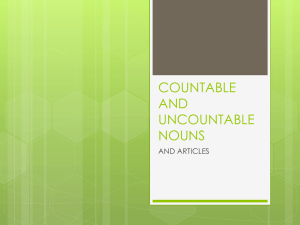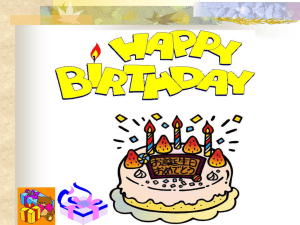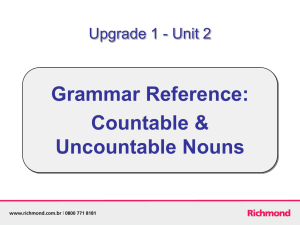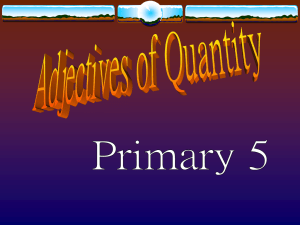File - Aslı Meryem`s E-Portfolio
advertisement
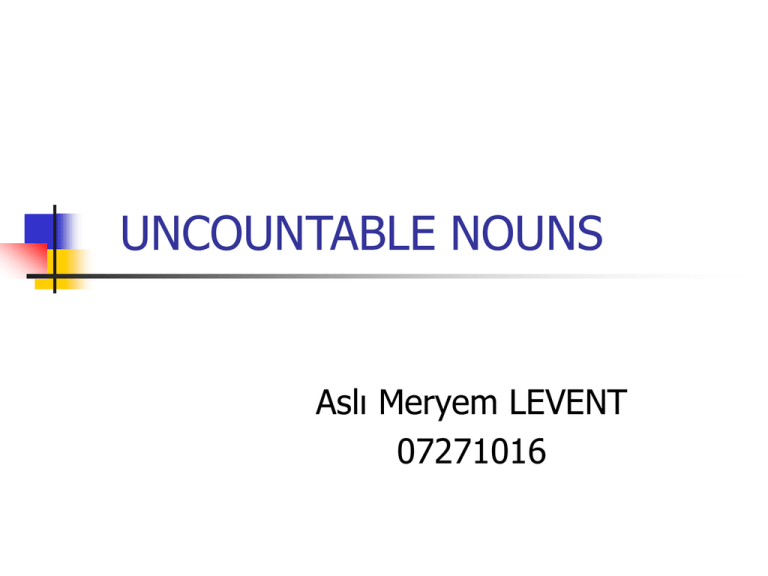
UNCOUNTABLE NOUNS Aslı Meryem LEVENT 07271016 LESSON PLAN Subject: Uncountable nouns Topic: Refreshments Grade: 9th grade Level: Intermediate Duration: 40’+40’ Approach: Communicative Language Teaching Skills: Listening, Reading, Writing, Speaking Techniques: Reading aloud, Questioning, Repetition, Filling the blanks, Pair work, Peer correction Role of the students: Communicator, Performer, Active participant, Negotiator Role of the teacher: Organizer, Facilitator, Monitor, Director The nature of student-student and teacherstudent interaction: Students interact with both the teacher and each other. Expected errors: Misuse of uncountable nouns such as using “a/an” or plural with uncountable nouns Error Source: L1 (negative transference of the first language pattern to the foreign language and overgeneralization) Type of Corrective Feedback: Recast Materials: Reading dialogue, board, board marker, worksheets, pictures Why do I choose uncountable nouns? One of the subjects students have difficulty in understanding and they have mistakes Confusion of classifier-type expressions in Turkish The distinction in English between things treated as uncountable Why do I choose Communicative Approach? Communicative competence Learner-centered approach Social context and real-life situations Students’ interests and needs Classroom atmosphere PRESENTATION Warm-up and Motivation The teacher comes to the classroom and greets students as usual. She wants them to talk about that what kinds of food and drinks they like and how often they go shopping. After that, she shows some pictures and asks them to say how much food and drinks there are in Turkish. Thus, students perform a brainstorming activity. Through this activity, the teacher makes the students ready for the subject of the lesson. PRESENTATION Warm-up and Motivation Why do I use brainstorming? Questioning technique and systematic practice Improvement in learners’ inference ability Visual aids Useful for getting the students to predict what is coming next in a lesson Elicitation of the mistakes about classifiers Why do I benefit from Schema Theory? Necessity of the pre-existent knowledge of the world Heavy emphasis on the importance of the learners’ background knowledge or cultural base Association the knowledge with the new structure Efficiency of communication through shared schemata PRESENTATION Presenting the Instructional Objectives The teacher reads a dialogue that has uncountable nouns. The uncountable nouns are written in bold and underlined. PRESENTATION Presenting the Instructional Objectives Michael and Chris Taylor love being with friends. They often have parties at home. They are going to have a party at home. They are making a shopping list now Michael: Honey, do we have any drinks? Chris: Well, we have a lot of lemonade and some apple juice; but there isn’t any coke. Michael: Then, we are going to buy some coke. How much coke do we need? Chris: Five cans/tins of coke. Michael: OK, then I’m putting it on the shopping list. Do we need any vegetables? Chris: Yes, I’m going to make a carrot salad; but there aren’t any carrots. Michael: Not again! You always make carrot salad. Let’s make a Mediterranean salad this time. Chris: All right. Oh! We don’t have enough parsley to make a Mediterranean salad. Michael: No problem. I’m adding it to the list. Well, how much parsley do we have? Chris: Just a moment. We have some; but, we need two bunches of parsley more. Oh! We don’t have much oil, too. And we need a bottle of oil. Michael: OK, I’m adding a bottle of oil and two bunches of parsley. You make delicious chocolate cakes. Are going to make one? Chris: Yes, I am. I need a bag of flour, two pockets of butter, three bars of chocolate, and a jar of jam. Michael: OK, I’m putting them on the list. And eggs? Chris: Oh, I need some eggs, too. Michael: How many eggs do you need? Chris: Five Michael: OK, then. Now, we are going shopping. PRESENTATION Presenting the Instructional Objectives After that, she writes them with their translation equivalents on the board. English Turkish Five cans/tins of coke beş (teneke) kutu kola Two bunches of parsley iki demet maydanoz A bottle of oil bir şişe zeytinyağı A bag of flour bir torba un Two pockets of butter iki paket yağ Three bars of chocolate üç kalıp çikolata A jar of jam bir kavanoz reçel Then, she pronounces them and the students repeat after her. Thus, the students start to be aware of uncountable nouns. Why do I use reading material? Comprehensible input Communicative value and function as an active skill Meaningful and social context because of integration of the form and meaning Why do I write the uncountable nouns in bold and underlined at the presentation stage? Useful to draw learners’ attention to the features in the target language. Difference between countable and uncountable nouns Realization of classifier-type expressions with uncountable nouns Why do I write the uncountable nouns with their equivalents on the board? Decreasing the potential problems stemmed from the first language through contrastive analysis Grasping the similarities and differences between uncountable nouns in Turkish and English Helping the learners be aware of the classifier-type expressions with uncountable nouns PRACTICE The First Activity The teacher wants the students to fill the chart according to the dialogue in order to make them comprehend the text and aware of the expressions. PRACTICE Make the shopping list of Michael and Chris. WHAT e.g. coke HOW MANY parsley - - HOW MUCH five cans/tins of coke two bunches of parsley PRACTICE • The Second Activity After that, she wants the students to work with a pair and she gives another text to each student in pairs. She wants them to complete the text according to pictures. Then, they exchange their papers and check each other’s answers. PRACTICE Look and the picture and complete the text. My little son always has a piece of (1) c_ _ _ _ _, an (2) e_ _, some (3) h_ _ _ _ and a glass of (4) m_ _ _ for breakfast. At lunchtime he usually has a (5) h_ _ _ _ _ _ _ _, an (6) a_ _ _ _ and a bottle of (7) a_ _ _ _. Sometimes he eats a piece of chocolate (8) c_ _ _ with a can of (9) c_ _ _. In the afternoon, he often eats two (10) o_ _ _ _ _ _ and a (11) b_ _ _ _ _. For dinner he usually eats a bowl of (12) s_ _ _ and some grilled (13) s_ _ _ _ with (14) r_ _ _. Whenever he eats out, he prefers eating (15) d_ _ _ _ with a bowl of (16) s_ _ _ _. He usually drinks a glass of (17) a_ _ _ _. PRODUCTION In the production part, the teacher again wants them to work with a pair and gives a list to them. There are some food and drinks in the list and she gives a situation to them. For example, she says “You are going to have a party this Saturday. Prepare a shopping list for your party using these items”. Why do I use pair/group work? Learner-centered approach Allowing students to be in charge of their own learning Working and interacting independently without necessary guidance of the teacher Co-operation and negotiation Promoting learner independency and autonomy Why do I choose these activities for the learners? Helping the students communicate their needs and thoughts • • Meaningful context in which the language is useful • Presenting a variety of different linguistic forms used in a real language What kind of errors do I expect from my learners and what can the causes of them be? Using “a/an” or plural with uncountable nouns such as a butter, a chocolate, a good advice and informations The factor “overgeneralization” that the students make while they are developing their interlanguages Negative transference of the first language to the target language e.g. adding “a/an” to the uncountable nouns What kind of errors do I expect from my learners and what can the causes of them be? The difference between Turkish and English culture Different shared knowledge of cultural reference and discourse in their own language and culture from English Lack of linguistic relativity A type of cognitive categorization based on expression of quantity in English How should I correct these errors? Recast - implicit corrective feedback with repeating what the students say correctly or reformulating the sentence According to the studies, learners notice and respond to recasts in ways that contribute positively to their language development. Using at consistently high rate in management, communication and content exchanges Why do I adopt “Let’s talk” and “Get it right in the end” proposals? Comprehensible input and conversational interactions with teacher and other students The opportunity to negotiate for meaning Working together to achieve a particular goal in practice and production stages Helping the students express their thoughts, opinions and feelings in a free classroom environment Why do I adopt “Let’s talk” and “Get it right in the end” proposals? The balance between meaning-based and formbased learning and teaching activities Teaching some aspects of language explicitly Suitable for the learners sharing the same L1 because of not leading any kind of communication breakdown and difficulty in discovering errors on their own THANK YOU

